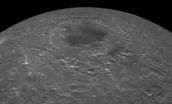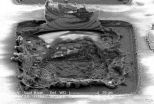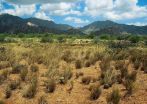(Press-News.org) PROVIDENCE, R.I. [Brown University] — Early in the Moon's history an ocean of molten rock covered its entire surface. As that lunar magma ocean cooled over millions of years, it differentiated to form the Moon's crust and mantle. But according to a new analysis by planetary scientists from Brown University, this wasn't the last time the Moon's surface was melted on a massive scale.
The research, led by graduate student William Vaughan, shows that the impact event that formed the Orientale basin on the Moon's western edge and far side produced a sea of melted rock 220 miles across and at least six miles deep. Similar seas of impact melt were probably present at various times in at least 30 other large impact basins on the Moon.
The research is published in the April issue of the journal Icarus.
Vaughan and his colleagues show that as these melt seas cooled, they differentiated in a way that was similar to the lunar magma ocean. As a result, rocks formed in melt seas could be mistaken for "pristine" rocks formed very early in the Moon's history, the researchers say.
"This work adds the concept of impact melt magma seas to the lexicon of lunar rock-forming processes," said planetary geologist James W. Head III, the Scherck Distinguished Professor of Geological Sciences and the senior researcher involved in the study. "It emphasizes that one must consider the detailed point of origin of the rocks in order to interpret them correctly."
That includes rocks brought back during the Apollo program and Russia's Luna missions. It's quite possible, the researchers say, that impact melt material is present in lunar samples thought to be representative of the early formation of the lunar crust. The amount of rock formed in melt seas is far from trivial. Vaughan and his colleagues estimate that impacts forming the Moon's 30 large basins produced 100 million cubic kilometers of melt, enough to make up 5 percent of the Moon's crust.
If lunar samples do include melt material, it would help to explain some puzzling findings from lunar samples. For example, in 2011 an analysis of a sample assumed to have originated in the early lunar crust suggested that the sample was 200 million years younger than the estimated time when the lunar magma ocean solidified. That led some researchers to conclude either that the Moon is younger than previously estimated or that the lunar magma ocean theory was flawed. But if that sample actually originated from a melt sea, its young age could be explained without rewriting the history of the Moon.
The melt sea at Orientale
The Orientale basin is only partly visible from Earth on the western edge of the Moon's near side. Because it's one of the few basins on the Moon that hasn't filled in with volcanic basalt, it provides a great place to investigate the geology of melt seas and to test whether they differentiate as they cool.
For the Orientale melt sea to have differentiated, it must have been liquid for a long time — thousands of years. To be liquid that long, it must have been quite thick. That left the researchers with a question that wasn't easy to answer: How thick was the Orientale melt?
"In pictures, you're just seeing the top of an impact melt body, so we have to find a way to infer how thick it was," Vaughan said.
To do that, Vaughan and his colleagues took advantage of the fact that a liquid shrinks when it cools and solidifies. Data from the Lunar Orbiter Laser Altimeter (LOLA) showed that the sheet had subsided by about two kilometers from the surrounding rock, giving the researchers an idea of how much the sea shrank. With that data, they could calculate its volume and infer its depth.
According to the calculations, the Orientale melt sea must have been at least 10 kilometers thick. Far shallower melt sheets from impacts on Earth are known to have differentiated, so it's a safe bet that Orientale was thick enough to differentiate.
The next question was what that differentiation might look like. Based on the compositions of the lunar crust and mantle material melted, Vaughan could determine the composition of the impact melt sea. From there, he could make a model of what rocks would have formed as the melt sea cooled. According to the model, thick layers of rocks like dunite and pyroxenite form at the base of the melt sea from dense, early crystallizing minerals that sink through the melt. Other minerals float up through the melt to form layers of rocks such as norite at the top of the melt sea — very similar to differentiation processes in the lunar magma ocean.
Vaughan's model is supported by remote sensing data from the Maunder crater, the remnant of an impact that excavated material from the melt sheet after it cooled. The data confirm a noritic composition at least four kilometers deep in the melt sheet.
Taken together, the findings suggest that impact melt seas produce rock in a way that's very similar to the lunar magma ocean. And that could help to clear up some lingering questions about the magma ocean paradigm.
"This is a mechanism by which the Moon was later modified to add petrologic complexity," Vaughan said. "It helps make sense of mineralogical data that doesn't always fit in this lunar magma ocean idea."
INFORMATION:
Editors: Brown University has a fiber link television studio available for domestic and international live and taped interviews, and maintains an ISDN line for radio interviews. For more information, call (401) 863-2476.
Lunar impacts created seas of molten rock, research shows
2013-03-12
ELSE PRESS RELEASES FROM THIS DATE:
Remote clouds responsible for climate models' glitch in tropical rainfall
2013-03-12
It seems counterintuitive that clouds over the Southern Ocean, which circles Antarctica, would cause rain in Zambia or the tropical island of Java. But new research finds that one of the most persistent biases in global climate models – a phantom band of rainfall just south of the equator that does not occur in reality – is caused by poor simulation of the cloud cover thousands of miles farther to the south.
University of Washington atmospheric scientists hope their results help explain why global climate models mistakenly duplicate the inter-tropical convergence zone, ...
Long-suspected cause of blindness from eye disease disproved
2013-03-12
(SALT LAKE CITY)—Vision scientists long have thought that lack of very long chain fatty acids in photoreceptor cells caused blindness in children with Stargardt type 3 retinal degeneration, an incurable eye disease. But researchers at the University of Utah's John A. Moran Eye Center have shown in a new study that lack of these fatty acids does not cause blindness, meaning that the search for the mechanism that robs sight from children with the disease must start anew.
Researchers led by David Krizaj, Ph.D., associate professor of ophthalmology and visual sciences at ...
Common erectile dysfunction drug not helpful for heart failure patients, study finds
2013-03-12
SAN FRANCISCO -- A commonly used erectile dysfunction drug, sildenafil, doesn't help patients who have heart failure with preserved ejection fraction, a condition in which the heart's lower chambers are stiff and cannot relax and fill fully between beats. That is the finding of the RELAX study, presented today at the American College of Cardiology's 62nd Annual Scientific Session and simultaneously published in The Journal of the American Medical Association. The study's lead author called the results disappointing.
Sildenafil, a phosphodiesterase-5 inhibitor, had shown ...
Astronomers conduct first remote reconnaissance of another solar system
2013-03-12
Researchers have conducted a remote reconnaissance of a distant solar system with a new telescope imaging system that sifts through the blinding light of stars. Using a suite of high-tech instrumentation and software called Project 1640, the scientists collected the first chemical fingerprints, or spectra, of this system's four red exoplanets, which orbit a star 128 light years away from Earth. A detailed description of the planets—showing how drastically different they are from the known worlds in the universe—was accepted Friday for publication in The Astrophysical Journal. ...
Creating indestructible self-healing circuits
2013-03-12
PASADENA, Calif.—Imagine that the chips in your smart phone or computer could repair and defend themselves on the fly, recovering in microseconds from problems ranging from less-than-ideal battery power to total transistor failure. It might sound like the stuff of science fiction, but a team of engineers at the California Institute of Technology (Caltech), for the first time ever, has developed just such self-healing integrated chips.
The team, made up of members of the High-Speed Integrated Circuits laboratory in Caltech's Division of Engineering and Applied Science, ...
Epigenetics mechanism may help explain effects of mom's nutrition on her children's health
2013-03-12
This press release is available in Spanish.
Pioneering studies by U. S. Department of Agriculture-funded research molecular geneticist Robert A. Waterland are helping explain how the foods that soon-to-be-moms eat in the days and weeks around the time of conception—or what's known as periconceptional nutrition–may affect the way genes function in her children, and her children's health.
In an early study, Waterland and co-investigators examined gene function of 50 healthy children living in rural villages in the West African nation of The Gambia. The study has shaped ...
Study shows how one insect got its wings
2013-03-12
COLUMBUS, Ohio – Scientists have delved deeper into the evolutionary history of the fruit fly than ever before to reveal the genetic activity that led to the development of wings – a key to the insect's ability to survive.
The wings themselves are common research models for this and other species' appendages. But until now, scientists did not know how the fruit fly, Drosophila melanogaster, first sprouted tiny buds that became flat wings.
A cluster of only 20 or so cells present in the fruit fly's first day of larval life was analyzed to connect a gene known to be active ...
Study predicts lag in summer rains over parts of US and Mexico
2013-03-12
A delay in the summer monsoon rains that fall over the southwestern United States and northwestern Mexico is expected in the coming decades according to a new study in the Journal of Geophysical Research. The North American monsoon delivers as much as 70 percent of the region's annual rainfall, watering crops and rangelands for an estimated 20 million people.
"We hope this information can be used with other studies to build realistic expectations for water resource availability in the future," said study lead author, Benjamin Cook, a climate scientist with joint appointments ...
Study shows on-pump bypass comparable to off-pump at year mark
2013-03-12
SAN FRANCISCO (March 11, 2013) — Patients who underwent heart bypass surgery without a heart- lung machine did as well one year later as patients whose hearts were connected to a pump during surgery in a study presented today at the American College of Cardiology's 62nd Annual Scientific Session.
CORONARY, an international, multicenter trial of on-pump (with a heart-lung machine) versus off-pump bypass surgery, enrolled 4,752 patients already scheduled to undergo a bypass procedure. The study is the largest to compare the two approaches.
For the primary endpoint of ...
University of Maryland School of Medicine discovers adaptations to explain strategies for survival on Mars
2013-03-12
Research from the University of Maryland School of Medicine has revealed key features in proteins needed for life to function on Mars and other extreme environments. The researchers, funded by NASA, studied organisms that survive in the extreme environment of Antarctica. They found subtle but significant differences between the core proteins in ordinary organisms and Haloarchaea, organisms that can tolerate severe conditions such as high salinity, desiccation, and extreme temperatures. The research gives scientists a window into how life could possibly adapt to exist on ...



